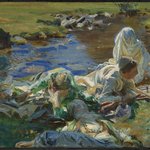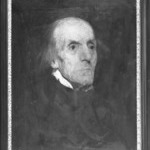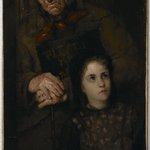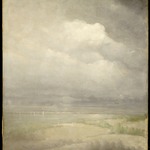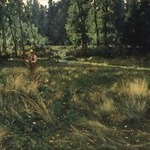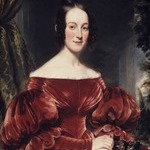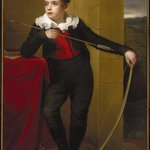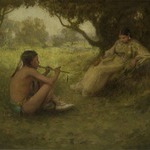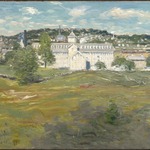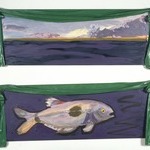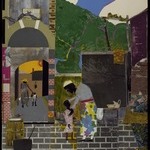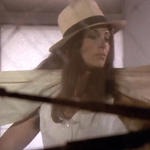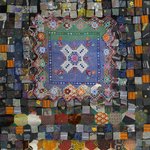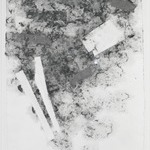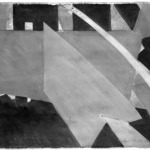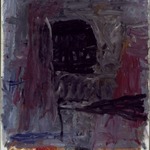
This image is presented as a "thumbnail" because it is protected by copyright. The Brooklyn Museum respects the rights of artists who retain the copyright to their work.

Philip Guston (American, born Canada, 1913–1980). Red Cloth, 1976. Oil on canvas, 78 × 105 1/2 × 1 1/2 in. (198.1 × 268 × 3.8 cm). Brooklyn Museum, Bequest of Musa Guston, 1992.211.2. © artist or artist's estate (Photo: Brooklyn Museum, 1992.211.2_PS9.jpg)
Red Cloth
Philip Guston
Contemporary Art
In the mid-1960s Philip Guston made a radical shift from lyrical abstraction to a cartoonlike style that reimagined scenes of historic brutality. In Red Cloth, Guston reckons with images from the Holocaust, the state-sponsored persecution and murder of Jews and others deemed undesirable by the Nazi regime during World War II. Illuminated by a single naked light bulb, the severed legs and boots recall the mounds of shoes that the Allied troops found in 1945 at the concentration camps of Auschwitz, Dachau, and Bergen-Belsen. A brilliant vermillion tapestry held aloft by two hands, which reference Manus Dei, or the Hand of God, an ancient Judeo-Christian motif, offsets the barren room. In Guston’s imaginative narrative, God’s intervention cannot stop the horrors of genocide.
MEDIUM
Oil on canvas
DATES
1976
DIMENSIONS
78 × 105 1/2 × 1 1/2 in. (198.1 × 268 × 3.8 cm) (show scale)
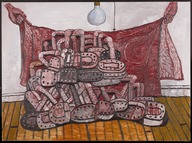


MARKINGS
Paper label attached to crossbar, left half, "49. RED CLOTH 1976 78 x 105 1/2"
SIGNATURE
Upper left verso: PHILIP GUSTON/"RED CLOTH" 1976 OIL ON CANVAS/78 x 105 1/2"
COLLECTIONS
Contemporary Art
ACCESSION NUMBER
1992.211.2
CREDIT LINE
Bequest of Musa Guston
MUSEUM LOCATION
This item is not on view
CAPTION
Philip Guston (American, born Canada, 1913–1980). Red Cloth, 1976. Oil on canvas, 78 × 105 1/2 × 1 1/2 in. (198.1 × 268 × 3.8 cm). Brooklyn Museum, Bequest of Musa Guston, 1992.211.2. © artist or artist's estate (Photo: Brooklyn Museum, 1992.211.2_PS9.jpg)
IMAGE
overall, 1992.211.2_PS9.jpg. Brooklyn Museum photograph, 2013
"CUR" at the beginning of an image file name means that the image was created by a curatorial staff member. These study images may be digital point-and-shoot photographs, when we don\'t yet have high-quality studio photography, or they may be scans of older negatives, slides, or photographic prints, providing historical documentation of the object.
RIGHTS STATEMENT
© artist or artist's estate
Copyright for this work may be controlled by the artist, the artist's estate, or other rights holders. A more detailed analysis of its rights history may, however, place it in the public domain.
The Museum does not warrant that the use of this work will not infringe on the rights of third parties. It is your responsibility to determine and satisfy copyright or other use restrictions before copying, transmitting, or making other use of protected items beyond that allowed by "fair use," as such term is understood under the United States Copyright Act.
For further information about copyright, we recommend resources at the United States Library of Congress, Cornell University, Copyright and Cultural Institutions: Guidelines for U.S. Libraries, Archives, and Museums, and Copyright Watch.
For more information about the Museum's rights project, including how rights types are assigned, please see our blog posts on copyright.
If you have any information regarding this work and rights to it, please contact copyright@brooklynmuseum.org.
RECORD COMPLETENESS
Not every record you will find here is complete. More information is available for some works than for others, and some entries have been updated more recently. Records are frequently reviewed and revised, and we welcome any additional information you might have.



